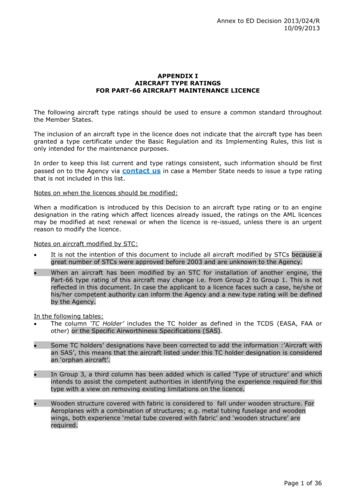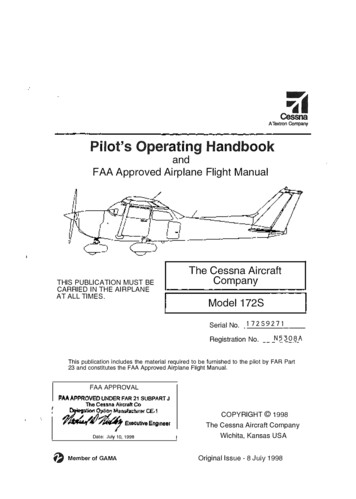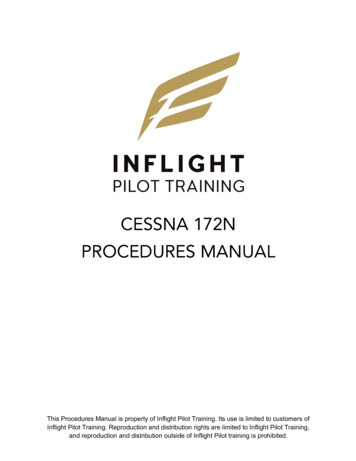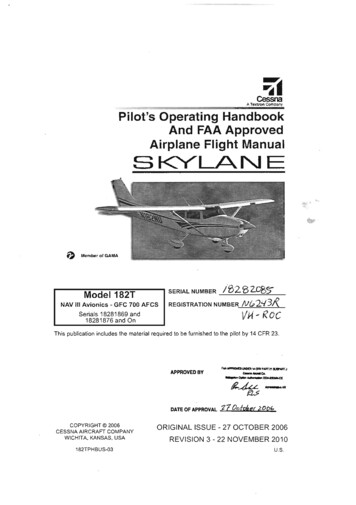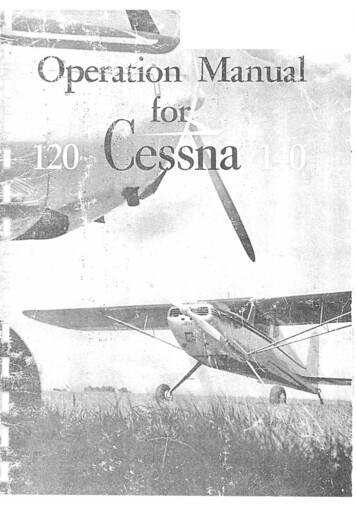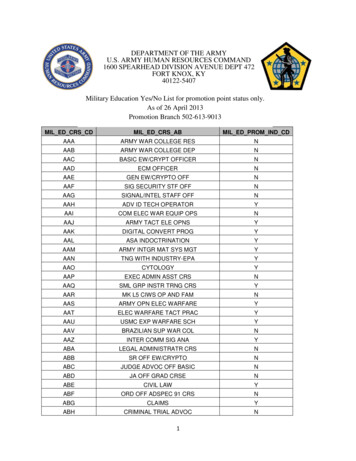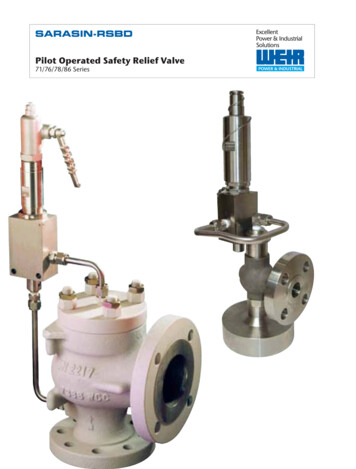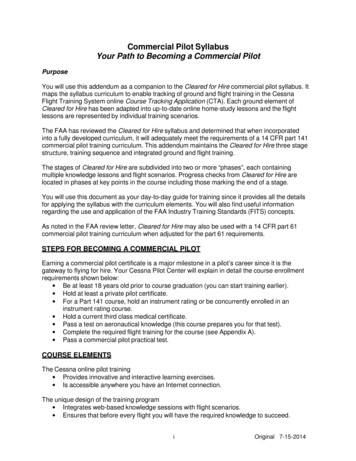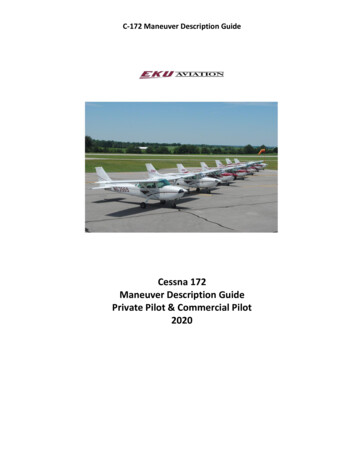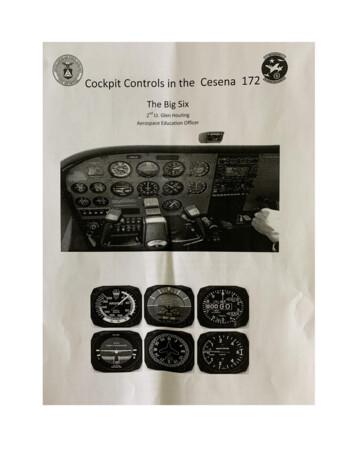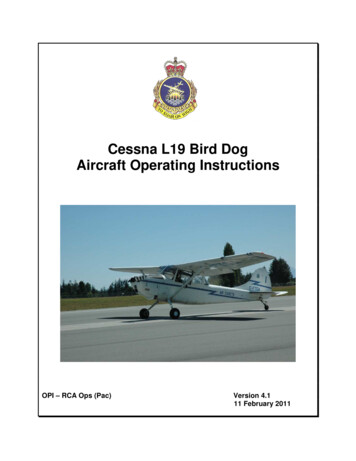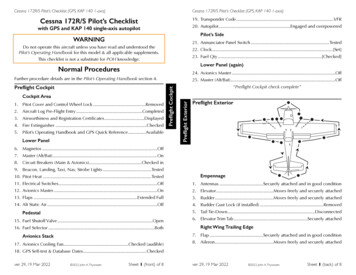
Transcription
Cessna 172R/S Pilot’s Checklist (GPS, KAP 140 1-axis)Cessna 172R/S Pilot’s Checklist (GPS, KAP 140 1-axis)19. Transponder Code .VFRCessna 172R/S Pilot’s Checklist20. Autopilot .Engaged and overpoweredwith GPS and KAP 140 single-axis autopilotPilot’s SideWARNING21. Annunciator Panel Switch .TestedDo not operate this aircraft unless you have read and understood thePilot’s Operating Handbook for this model & all applicable supplements.22. Clock.[Set]23. Fuel Qty .[Checked]This checklist is not a substitute for POH knowledge.Lower Panel (again)Normal Procedures24. Avionics Master .OffFurther procedure details are in the Pilot’s Operating Handbook section 4.1. Pitot Cover and Control Wheel Lock .Removed2. Aircraft Log Pre-Flight Entry .Completed3. Airworthiness and Registration Certi cates .Displayed4. Fire Extinguisher .Checked5. Pilot’s Operating Handbook and GPS Quick Reference .AvailableLower Panel“Pre ight Cockpit check complete”Pre ight ExteriorCockpit AreaPre ight CockpitPre ight Cockpit25. Master (Alt/Bat) .OffPre ight Exterior6. Magnetos .Off7. Master (Alt/Bat) .On8. Circuit Breakers (Main & Avionics) .Checked in9. Beacon, Landing, Taxi, Nav, Strobe Lights .Tested10. Pitot Heat .TestedEmpennage11. Electrical Switches .Off1. Antennas .Securely attached and in good condition12. Avionics Master .On2. Elevator .Moves freely and securely attached13. Flaps .Extended Full3. Rudder .Moves freely and securely attached14. Alt Static Air .Off4. Rudder Gust Lock (if installed) .Removed5. Tail Tie-Down.DisconnectedPedestal15. Fuel Shutoff Valve .Open16. Fuel Selector .Both6. Elevator Trim Tab .Securely attachedRight Wing Trailing Edge7. Flap .Securely attached and in good conditionAvionics Stack17. Avionics Cooling Fan.Checked (audible)8. Aileron .Moves freely and securely attached18. GPS Self-test & Database Dates.Checked 2022 John A. Thywissenfiflflflflflver. 29, 19 Mar 2022Sheet 1 (front) of 8ver. 29, 19 Mar 2022 2022 John A. ThywissenSheet 1 (back) of 8
Cessna 172R/S Pilot’s Checklist (GPS, KAP 140 1-axis)Right Wing Leading Edge9. Wing Tie-Down .Disconnected10. Fuel Tank Sump Quick Drain Valves .Sampled & checked fuel (5 points)11. Main Wheel Tire .In ated and in good condition12. Fuel Quantity .Checked visuallyBefore StartCessna 172R/S Pilot’s Checklist (GPS, KAP 140 1-axis)13. Fuel Filler Cap .Vent unobstructed and cap secureBefore Start1. Tie-Downs, Chocks, and Tow Bar .Removed2. Seats & Seat Belts .Adjusted & locked3. Master (Alt/Bat) .On4. Beacon .On5. Avionics Master .Off6. Fuel Shutoff Valve .OpenNose7. Fuel Selector .Both14. Engine Oil Level .[5–8 qt]“Before Start check complete”(Avoid used engine oil—possible carcinogen. Wash off with soap.)15. Engine Oil Dipstick/Filler Cap .SecureStart16. Fuel Strainer Quick Drain Valve .Sampled & checked fuelSee POH section 4, Ampli ed Procedures subsection, for start procedures.17. Engine Cooling Air Inlets .Clear of obstructionsStart type: Normal18. Propeller & Spinner .Free of nicks and securely attachedHotFlooded19. Air Filter .CleanPrimeYesNoNo20. Nose Wheel Strut .In atedMixtureCut-OffCut-OffCut-Off21. Nose Wheel Tire .In ated and in good conditionThrottle1/4 inch1/4 inchHalf to full open22. Left Static Source Opening.No blockagePriming: If engine is not warm: Throttle open 1/4 inch. Fuel pump on. Mixturerich. Await stable fuel ow indication. Mixture cut-off. Fuel pump off.As engine starts, immediately mixture to full rich, throttle to 1000 rpm.Starter cycle limits: crank 10 sec — cool 20 sec — crank 10 sec — cool 20 sec— crank 10 sec — cool 10 min — repeat once, then get assistance.Left Wing Leading Edge23. Fuel Quantity .Checked visually25. Pitot Tube, Stall Warning,& Fuel Tank Vent .No blockage26. Landing & Taxi Lights.Cover in good condition and clean27. Wing Tie-Down .Disconnected28. Fuel Tank Sump Quick Drain Valves .Sampled & checked fuel (5 points)29. Main Wheel Tire .In ated and in good conditionLeft Wing Trailing EdgeAfter Start24. Fuel Filler Cap .Vent unobstructed and cap secureAfter Start1. Oil Press .Checked(Shutdown engine if oil pressure not normal within 30 seconds of start.)2. Ammeter .Positive (charging)3. (if skyBeacon-equipped or sunset–sunrise) Nav Lights .OnIf skyBeacon-equipped, nav lights must be on (day & night) for ADS-B out.30. Aileron .Moves freely and securely attached4. Avionics Master .On31. Flap .Securely attached and in good condition5. Flaps .Up6. Mixture .Leaned for ground operationsBaggage Area32. Baggage Door .Latched“Pre ight Exterior check complete”(Set throttle to 1200 rpm. Lean for max rpm. Reset throttle to 1000 rpm.)7. GPS Startup Pages.Acknowledged8. Transponder .ALT mode / [Code set]9. Instruments .[Set]“After Start check complete”Sheet 2 (front) of 8flflflfl 2022 John A. Thywissenfiflflver. 29, 19 Mar 2022ver. 29, 19 Mar 2022 2022 John A. ThywissenSheet 2 (back) of 8
Cessna 172R/S Pilot’s Checklist (GPS, KAP 140 1-axis)Run-Up! Brief Takeoff1. Seats, Seat Backs & Seat Belts .Secure & upright2. Cabin Doors .Closed & lockedRun-UpCessna 172R/S Pilot’s Checklist (GPS, KAP 140 1-axis)Threats: What are our threats this takeoff?Plan: Runway Type (speeds, aps) Abort pt & proc Climb speeds,power Initial heading & altitude Return Route (ODP, SID) Nav setupCountermeasures: Extra actions or considerations to manage threats.3. Flight Controls .Free & correct4. Mixture .Full RichNormal Takeoff: aps upRotation .55 KIASTakeoff (to 50 ft).75 KIAS5. Checked at 1800 rpm:5.a. Magneto Check .Complete(Check drop less than 150 rpm. Less than 50 rpm difference betweenmagnetos.)Short Field Takeoff: aps 10 Rotation .51 KIASTakeoff (to clear obs.).57 KIASFlaps up when clear, 60 KIAS5.b. Oil Temp & Press .Checked5.c. Vac .Checked5.f. Annunciator Panel .Clear (none lit)6. Throttle .Idle checked7. Throttle Friction Lock .Set8. Mixture .Leaned for ground operations9. Autopilot .DisengagedBefore Takeoff5.d. Alternator Check .Complete5.e. Voltmeter .[27.5–28.8 V]15. CDI Navigation Source .[GPS/VLOC]18. Instruments & GPS .Review warning, caution, or advisory indications19. Fuel Qty .[Checked]2. (If installed) Air Conditioning .Off3. Mixture .(at or below 3000 density alt.) Full Rich(above 3000 density alt.) Leaned (for max rpm at full throttle)After TakeoffCruise16. Transponder .ALT mode / [Code set]17. Instruments .[Set](entering runway)1. Flaps .[Up or 10 ]After Takeoff14. Nav.SetBefore TakeoffCruise13. Fuel Selector .BothInitial climb (50–1000 ft) .78 KIASEn route climb .80–86 KIAS“Before Takeoff check complete”If skyBeacon-equipped, nav lights must be on (day & night) for ADS-B out.12. Fuel Shutoff Valve .OpenSoft Field Takeoff: aps 10 Rotation .ASAPTakeoff (to clear obs.) .57 KIASTakeoff (no obstacles) .75 KIASFlaps up when clear, 60 KIAS4. Landing & Strobe Lights .On10. (if skyBeacon-equipped or sunset–sunrise) Nav Lights .On11. Elevator Trim .Take-off position(ready for TO)(roughly 200 ft AGL)1. Flaps .Check up2. (above 3000 density alt.) Mixture .Leaned3. Landing Light .Off“After Takeoff check complete”(after level-off)1. Taxi Light .Off (Leave on in high traf c areas)2. Throttle .[Cruise power]3. Mixture .Leaned“Run-up check complete”4. Fuel Qty .[Checked]APICC“Cruise check complete”Sheet 3 (front) of 8fifi 2022 John A. Thywissenflflflflver. 29, 19 Mar 2022Pre-Maneuver Check (APICC)(before a training maneuver)Altitude, Position, Instruments, Clearing turns, Con gurever. 29, 19 Mar 2022 2022 John A. ThywissenSheet 3 (back) of 8
(before leaving cruise)1. Taxi Light .On2. Nav & Comm.Set3. CDI Navigation Source .[GPS/VLOC]4. Instruments .[Set]5. Fuel Qty .[Checked]Before LandingDescentCessna 172R/S Pilot’s Checklist (GPS, KAP 140 1-axis)DescentCessna 172R/S Pilot’s Checklist (GPS, KAP 140 1-axis)Before Landing1. Flaps .10 2. (If installed) Air Conditioning .Off3. Mixture .Full Rich4. Fuel Selector .Both5. Autopilot .Disengaged6. Seats, Seat Backs & Seat Belts .Secure & upright1. Landing & Taxi Lights .On2. Fuel Selector .Both3. Approach Procedure (in GPS).Loaded4. CDI Navigation Source .[GPS/VLOC]5. Instruments .[Set]6. Timer .Ready“Approach check complete”! Brief Approach / LandingApproach(setting up approach)Shutdown After Landing“Before Landing check complete”“Descent check complete”(IFR) Approach(after ATIS and set up)At each waypoint in an instrument approach, do the 5 Ts, as applicable:Turn (course)–Time (start timer)–Twist (OBS)–Throttle (descend)–Talk (radio)(clear of runway)1. Flaps .Up2. Mixture .Leaned for ground operations3. Landing & Strobe Lights .Off“After Landing check complete”Shutdown1. Transponder code .VFR2. (if activated) Flight plan .Closed3. Avionics Master .Off5. Throttle .Closed6. Magnetos .Off7. Electrical Switches .Off8. Master (Alt/Bat) .Off9. Fuel Selector .Left or RightFinal (normal) .65 KIASFinal (no aps) .70 KIASFinal (short eld) .62 KIAS10. Control Wheel Lock .Installed“Shutdown check complete”SecuringGo-around (initial) .(172R) 55 KIAS(172S) 60 KIASAfter Landing4. Mixture .Cut-OffThreats: What are our threats this approach / landing?Plan–Instrument approach: Proc title & rev NoPT?, No FAF?, Straight-in/Sidestep/Circle? FAF alt, step downs, DH/MDA Lighting MAP RadiosPlan–VFR landing: Runway Pattern direction, altitude, & entry Type(speeds, aps) Lighting Go-around RadiosCountermeasures: Extra actions or considerations to manage threats.Instrument approach .90 KIASPattern (downwind) .85 KIAS(abeam touchdown point/at FAF)Securing1. Aircraft Log.Completed2. Equipment Discrepancies .Reported & logged3. Panel, Radio, Pedestal, Glareshield, & Map Lights .Full dim4. Master (Alt/Bat) .Off5. Chocks/tie-downs, Pitot cover, and Sunshades .Installed6. Parking brake .Released (after chocks/tie-downs installed)7. Cockpit and cabin .Clean and free of trash“Securing check complete”fiflflver. 29, 19 Mar 2022 2022 John A. ThywissenSheet 4 (front) of 8ver. 29, 19 Mar 2022 2022 John A. ThywissenSheet 4 (back) of 8
Cessna 172R/S Pilot’s Checklist (GPS, KAP 140 1-axis)Abnormal ProceduresStatic Source Blockage (Erroneous Instrument Reading Suspected)1. ALT STATIC AIR Valve .PULL ON2. CABIN HT and CABIN AIR Knobs .PULL ON3. Vents .CLOSED4. Airspeed.Refer to POH Section 5, Figure 5-1 (Sheet 2)Static SourceFurther procedure details are in the Pilot’s Operating Handbook section 3.Low VoltageCessna 172R/S Pilot’s Checklist (GPS, KAP 140 1-axis)2. Alternator Field Circuit Breaker (ALT FLD) .CHECK IN3. Master Switch.OFF (both sides)4. Master Switch .ONLanding with Flat Main Tire5. Low Voltage Annunciator (VOLTS) .CHECK OFF1. Approach .NORMAL6. Avionics Master Switch .ONIf low voltage annunciator (VOLTS) illuminates again:2. Wing Flaps .30 7. Alternator .OFF3. Touchdown .GOOD MAIN TIRE FIRST8. Nonessential Radio and Electrical Equipment .OFF1. Approach .NORMAL2. Wing Flaps .AS REQUIRED3. Touchdown .ON MAINS(Hold nose wheel off the ground as long as possible)Ammeter Shows Excessive Rate of Charge (Full Scale)1. MASTER Switch (ALT Only) .OFFCAUTIONWith the alternator side of the master switch off,compass deviations of as much as 25 degrees may occur.2. Nonessential Electrical Equipment .OFF3. Flight .TERMINATE as soon as practicalSheet 5 (front) of 8fl 2022 John A. Thywissenflflver. 29, 19 Mar 2022Ammeter Full Scale4. Elevator (when nose wheel touches down) .Maintain FULL UP until stopVacuum FailureLanding with Flat Nose TireVacuum System FailureFuel Vapor(Using brake on good wheel as required)9. Flight .TERMINATE as soon as practicalExcessive Fuel Vapor (Fuel Flow Stabilization Procedures)Vacuum Annunciator Illuminates (L VAC) or (VAC R)CAUTIONIf vacuum is not within normal operating limits,partial panel procedures may be required for continued ight.1. Vacuum Gage .CHECK(If ow uctuations of 1 GPH or more or power surges occur.)1. Auxiliary Fuel Pump Switch .ON2. Mixture .ADJUST for smooth operation3. Fuel Selector Valve .SELECT OPPOSITE TANK if symptoms continue4. Auxiliary Fuel Pump Switch .OFF after fuel ow has stabilizedGPS DR/LOI4. Directional Control .MAINTAINFlat Tire(Hold airplane off at tire as long as possible with aileron control)flNOTEIllumination of VOLTS on the annunciator panel may occur during low RPMconditions with an electrical load on the system such as during a low RPM taxi.Under these conditions, the annunciator will go out at higher RPM. The masterswitch need not be recycled since an over-voltage condition has not occurred todeactivate the alternator system.1. Avionics Master Switch .OFF“Airspeed Calibration, Alternate Static Source” correction chartflLow Voltage Annunciator (VOLTS) / Ammeter DischargeGPS Loss of Signal (“DR” or “LOI” Indicated)1. Navigation source .Use alternative means of navigation, if availableIf no other navigation source available and “DR” is displayed, use GPStemporarily en route. No terminal or approach procedures will be available.2. (If in IMC) Route .Toward visual meteorological conditions (VMC)ver. 29, 19 Mar 2022 2022 John A. ThywissenSheet 5 (back) of 8
Cessna 172R/S Pilot’s Checklist (GPS, KAP 140 1-axis)Cessna 172R/S Pilot’s Checklist (GPS, KAP 140 1-axis)Emergency ProceduresEmergency Landing without Engine Power1. Pilot and Passenger Seat Backs .MOST UPRIGHT POSITIONFurther procedure details are in the Pilot’s Operating Handbook section 3.Items in boldface are immediate action items which should be memorized.2. Seats and Seat Belts .SECURE3. Airspeed.172R: 65 KIAS ( aps UP) / 60 KIAS ( aps DOWN)Engine Failure During Takeoff Roll172S: 70 KIAS ( aps UP) / 65 KIAS ( aps DOWN)1. Throttle .IDLE4. Mixture .IDLE CUTOFF2. Brakes .APPLY5. Fuel Shutoff Valve .OFF (Pull Full Out)3. Wing Flaps .RETRACT6. Magnetos Switch.OFF4. Mixture .IDLE CUTOFF7. ELT .ACTIVATE (if rescue needed)5. Magnetos Switch.OFF8. Wing Flaps.AS REQUIRED (30 recommended)6. Master Switch .OFF9. Master Switch .OFF (when landing is assured)10. Doors .UNLATCH PRIOR TO TOUCHDOWN1. Airspeed .172R: 65 KIAS ( aps UP) / 60 KIAS ( aps DOWN)11. Touchdown.SLIGHTLY TAIL LOW172S: 70 KIAS ( aps UP) / 65 KIAS ( aps DOWN)2. Mixture .IDLE CUTOFF4. Magnetos Switch.OFF5. Wing Flaps .AS REQUIRED6. Master Switch .OFF7. Cabin Door.UNLATCH8. Land .STRAIGHT AHEADEngine Failure3. Fuel Shutoff Valve .OFF (Pull Full Out)Forced LandingEngine Failure Immediately After Takeoff12. Brakes.APPLY HEAVILYPrecautionary Landing with Engine Power1. Pilot and Passenger Seat Backs .MOST UPRIGHT POSITION2. Seats and Seat Belts .SECURE3. Airspeed .65 KIAS4. Wing Flaps .20 5. Selected Field .FLY OVER, noting terrain and obstructions,then retract aps upon reaching a safe altitude and airspeedEngine Failure In Flight (Restart Procedures)6. Avionics Master Switch and Electrical Switches .OFF1. Airspeed .172R: 65 KIAS 172S: 68 KIAS7. ELT .ACTIVATE (if rescue needed)2. Fuel Shutoff Valve .ON (push full in)8. Wing Flaps .30 (on nal approach)3. Fuel Selector Valve .BOTH9. Airspeed .172R: 60 KIAS 172S: 65 KIAS4. Auxiliary Fuel Pump Switch .ON10. Master Switch .OFF5. Mixture .RICH (if restart has not occurred)11. Doors .UNLATCH PRIOR TO TOUCHDOWN6. Magnetos Switch .BOTH (or START if propeller is stopped)12. Touchdown.SLIGHTLY TAIL LOWNOTEIf the propeller is windmilling, the engine will restart automatically within a fewseconds. If the propeller has stopped (possible at low speeds), turn the Magnetosswitch to START, advance the throttle slowly from idle and lean the mixture fromfull rich as required for smooth operation.13. Magnetos Switch.OFF14. Brakes.APPLY HEAVILY15. Mixture .IDLE CUTOFF7. Auxiliary Fuel Pump Switch .OFF,Back ON if fuel ow drops to zeroSheet 6 (front) of 8flflfiflflfl 2022 John A. Thywissenflflflflflver. 29, 19 Mar 2022ver. 29, 19 Mar 2022 2022 John A. ThywissenSheet 6 (back) of 8
Cessna 172R/S Pilot’s Checklist (GPS, KAP 140 1-axis)DitchingEngine Fire During Start1. Radio .TRANSM
Cessna 172R/S Pilot's Checklist (GPS, KAP 140 1-axis) Cessna 172R/S Pilot's Checklist (GPS, KAP 140 1-axis) Abnormal Procedures Further procedure details are in the Pilot's Operating Handbook section 3. Static Source Blockage (Erroneous Instrument Reading Suspected) 1. ALT STATIC AIR Valve PULL ON.
